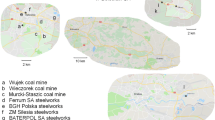Abstract
The main objective of our research was to compare the airborne particle micromorphology and chemistry in the Brussels environment during agriculture working periods in the surrounding farming region. We used specific methods and instrumentation that are adapted to the climate peculiarities of the Brussels region, the period of investigations (12 months) and the proposed objectives. For the agricultural works we defined the following six periods: before sowing, sowing, after sowing, before harvest, harvest and after harvest. The results indicate a possible temporal correlation between agricultural work periods and airborne particle concentration, micromorphology and chemistry in the Brabant–Brussels region. For wheat and corn plant-growth periods, the average particle size, defined as the area obtained by a planar projection of the particulate, showed important variations in time. For sugar beet and endive, the average area size variations are less important. The roughness and sphericity parameters for the growth periods of the four different plants also showed significant differences. Many of the larger particulates (>10 μm) are aggregates of even finer particles coated with many still finer ones. The airborne particle chemistry averages (atomic percentage At%), showed that three constituents (Si, S and Fe) dominate all the samples (except for particles 3–10 μm in size, which contain a relatively large percentage of Al).
Applying similar investigation methods to study the correlations between airborne particle dynamics in urban zones and the agriculture working periods in their surrounding regions could be of interest to better understand the complexity of the PM problematic.
Similar content being viewed by others
References
Alshibli, K. A., Asce, M., Alsaleh, M. I., & Asce, A. M. (2004). Characterizing surface roughness and shape of sands using digital microscopy. Journal of Computing in Civil Engineering, 18, 36–45.
Bastenier, H., Pinto-Quezada, C., & Hublet, P. (1967). Atmospheric pollution of industrial origin in Belgium. Acta Tuberculosea et Pneumologica Belgica, 58(6), 669–684.
Brenig, L., & Offer, Z. Y. (2001). Airborne particle dynamics: Towards a theoretical approach. Environmental Modeling and Assessment, 1, 1–5.
Buringh, E., & Opperhuizen, A. (Eds.) (2002). On health risks of ambient PM in the Netherlands (NAP) RIVM Rapp. 650010032, Bilthoven.
Crowder, T. M., Ropati, J. A., Schroeter, J. D., Hieky, A. J., & Martonen, T. B. (2002). Fundamental effects of particle morphology of lung delivery: Predictions of Stokes’ law and the particular relevance to dry powder inhaler formulation and development. Pharmaceutical Research, 19(3), 239–245.
Donat, J., & Ruck, B. (2004). Simulated ground deposition of fine airborne particles in an array of idealized tree crowns. Boundary Layer Meteorology, 93, 469–492.
Franck, U., & Herbarth, O. (2002). Using scanning electron microscopy for statistical characterization of the diameter and shaped of airborne particles at an urban location. Environmental Toxicology, 17, 98–104.
Goudie, A. S., & Middleton, N. J. (1992). The changing frequency of dust storms through time. Climatic Change, 20, 197–225.
Harrison, R. M., Yin, J., Mark, D., Stedman, J., Appleby, R. S., Booker, J., et al. (2001). Studies of the coarse particle (2.5–10 mm) component in the U.K. Urban atmosphere. Atmospheric Environment, 35, 3667–3679.
Kleeman, M., & Cass, G. R. (1998). Source contributions to the size and composition distribution of urban particulate air pollution. Atmospheric Environment, 32, 2803–2816.
Kupiainen, K., & Tervahattu, H. (2004). The effect of traction sanding on urban suspended particles in Finland. Environmental Monitoring and Assessment, 93, 287–300.
Maenhaut, W., & Cafmeyer, J. (1998). Long-term atmospheric aerosol study at urban and rural sites in Belgium. X-Ray Spectrometry, 17, 236–246.
Mensink, C. (2000). Validation of urban emission inventories. Environmental Monitoring and Assessment, 65, 31–39.
Offer, Z. Y., Brenig L., Carati, D. Vanderstraeten, P., Lenelle, Y., & Meurens, A. (2002). Airborne particle dynamics in the Brussels environment. Research in Brussels Actions, p. 106.
Rheis, M. C., & Kihl, R. (1995). Dust deposition in southern Nevada and California, 1984–1989: Relations to climate, source area, and source lithology. Journal of Geophysical Research, 100, 8893–8918.
Ruuskanen, J. (2001). Concentrations of ultrafine, fine and PM2,5 particles in three European cities. Atmospheric Environment, 35, 3729–3738.
Vanderstraeten, P., Lénelle, Y., Meurrens, P., Carati, D., Brenig, L., & Offer, Z. Y. (2006a). Airborne particle granulometry and micromorphology during working and non working days in the Brussels environment. Air Pollution, 86, 287–295.
Vanderstraeten, P., Lénelle, Y., Meurrens, A., Carati, D., Brenig, L., & Offer, Z. Y. (2006b). Temporal variations of airborne particles concentration in the Brussels environment. Environmental Monitoring and Assessment, 132, 253–262.
VMM (2003) VMM study – Comparison of PM10 measurement methods: Period 2001–2002 (in Dutch).
Wahlin, P. (2001). Pronounced decrease of ambient particle number emissions from diesel traffic in Denmark after reduction of the sulphur content in diesel fuel. Atmospheric Environment, 35, 3549–3552.
Widory, D. (2003). The origin of atmospheric particles (PM10) in the air of Paris: A multi-isotopic approach. Golds Conf. Abstr. P. A531.
Author information
Authors and Affiliations
Corresponding author
Rights and permissions
About this article
Cite this article
Vanderstraeten, P., Lénelle, Y., Meurrens, A. et al. Micromorphology and chemistry of airborne particles in Brussels during agriculture working periods in surrounding region. Environ Monit Assess 146, 33–39 (2008). https://doi.org/10.1007/s10661-007-0057-9
Received:
Accepted:
Published:
Issue Date:
DOI: https://doi.org/10.1007/s10661-007-0057-9




